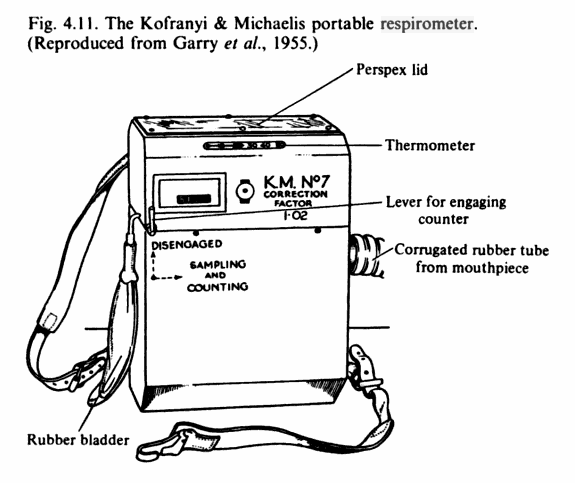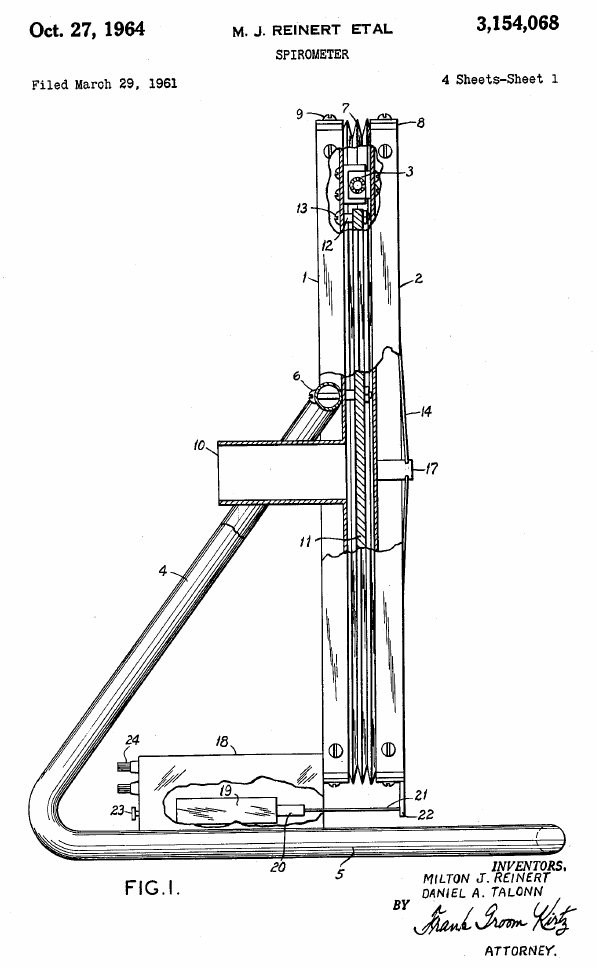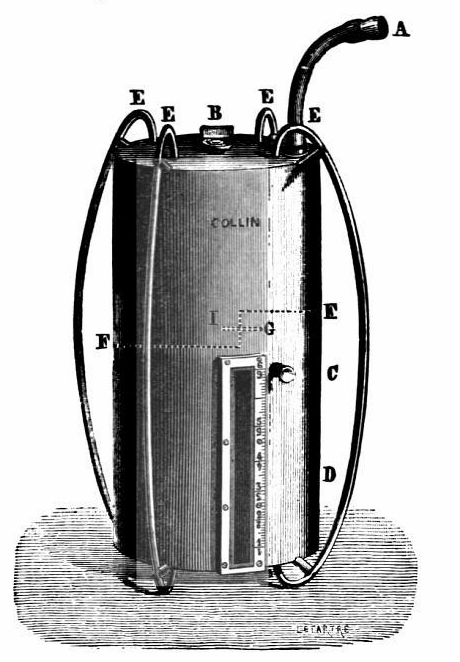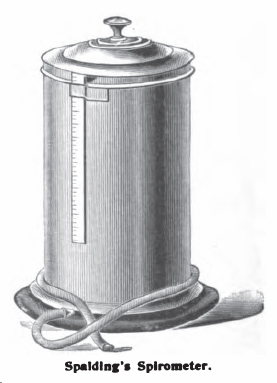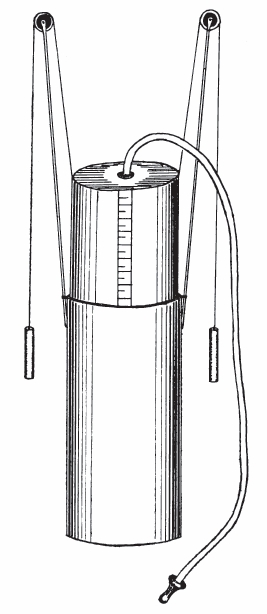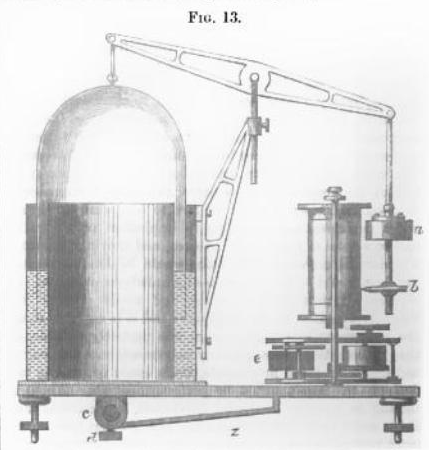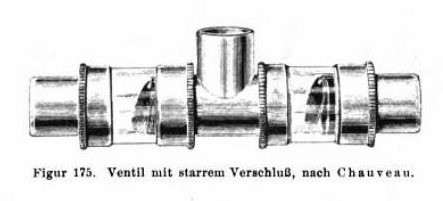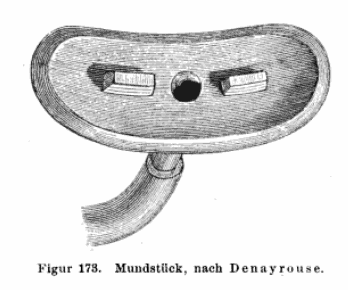From: Animal and Human Calorimetry by J. A. McLean, G. Tobin, Cambridge University Press, Dec 3, 2007, page 83.
Category Archives: Drawing
Spirometer, Med-Science Wedge Spirometer, 1964
A drawing from patent #3,154,068, submitted 1961, approved 1964.
“Another object of the invention is to provide a high dynamics spirometer. The instrument is designed to have small travel of the parts in motion corresponding to large volume differentials or changes in volume. Therefore large volumetric acceleration with correspond to small linear acceleration. Since for a given mass in motion, the lower the accelerations, the higher will be the frequency response.
“Another object of the invention is to provide a spirometer which will offer all the known functions of previous spirometers, and at the same time provide an electrical readout of both volume change and flow changes. These two measurements are entirely independent. Previous to this invention, no patient-driven spirometer has been capable of independent readout of volume changes and flow changes.
“The low linear acceleration results in small forces required to actuate the moving elements. Since the patient’s lungs in mechanical spirometry are required to generate the forces to drive the spirometer, it can readily be seen that the lower linear accelerations result in lower forces in the lungs to drive the spirometer. Thus the patient’s breathing is more nearly normal during the process of measurement. The effect is magnified at the point of higher dynamics, such as rapid breathing and coughing.
“In an ordinary spirometer, a patient coughing is not only affected physiologically by the higher forces of the ordinary spirometer, but the actual cough is recorded subject to the errors of the instrument at high frequencies.
“A further object of this invention is to provide a spirometer in which the ambient pressures within the spirometer and the patient’s lungs remain as close to atmospheric pressure as possible. Thus the patient does not have the feeling that something is impeding his breath, which is the case in the ordinary spirometer.”
Spirometer, Joal’s, 1895
From “On respiration in singing” by Joseph Joal, Published by F.J. Rebman, 1895, page 84.
“…this instrument has a double Mariotte’s vase, composed of two chambers, placed over one another and separated by two semi-circular diaphragms, F H, which are joined by a vertical septum. The two chambers are put into communication by tube I. The apparatus being half full of water, and the liquid filling the upper reservoir, if we breathe by the mouthpiece A, a quantity of water is displaced, and flows out of the upper reservoir, into the lower one; the graduated glass permitting us to determine the level of the liquid.
“When the upper chamber is empty it suffices to turn the instrument upside down, corking the tube E, and placing the mouthpiece on the chamber D, at the same time that we raise the screw C, and close the opening C.”
Spirometer, George Bellange, 1883
Described in the August 11, 1882 issue of Medical News. “New spirometer: M.G. Bellange has recently constructed an apparatus for the measurement of the capacity of the chest, the amount of air expired in a given time, and the amount of exhaled gases. It consists of a mouthpiece, a spirometer and a carbonimeter.” Taken from: http://www.webimed.net/Spiro_1889.html
Spirometer, Spalding’s, 1901
From: A manual for physical measurements for use in normal schools: public and preparatory schools, boys’ clubs, girls’ clubs, and young men’s Christian associations, with anthropometric tables for each height of each age and sex from five to twenty years, and vitality coefficients, by William Walter Hastings, Phd. Published by the International Young Men’s Christian Association Training School, 1901. page 18.
“The pupil, after loosening the clothing about the chest and taking a full inspiration, filling the lungs completely, should blow steadily into the spirometer until all the air possible has been expelled from the lungs. Two or three trials may be allowed.”
Recording U-Tube Mercury Manometer
A recording mercury U-tube manometer. The float in the left side of the U-tube moves up and down in response to respiratory pressures. The thin metal rod attached to the float had a recording pen at its tip.
From Das Stottern. Eine Monographie für Aerzte, Pädagogen und Behörden by Hermann Gutzmann, published by Rosenheim, 1898. page 149.
Spirometer, Modified Hutchinson, 1898
Purported to be a Hutchinson spirometer in the text of the article, this looks a lot more like a conglomeration of several different designs instead. The manufacturer was not named but was likely German.
From Das Stottern. Eine Monographie für Aerzte, Pädagogen und Behörden by Hermann Gutzmann, published by Rosenheim, 1898. page 148.
